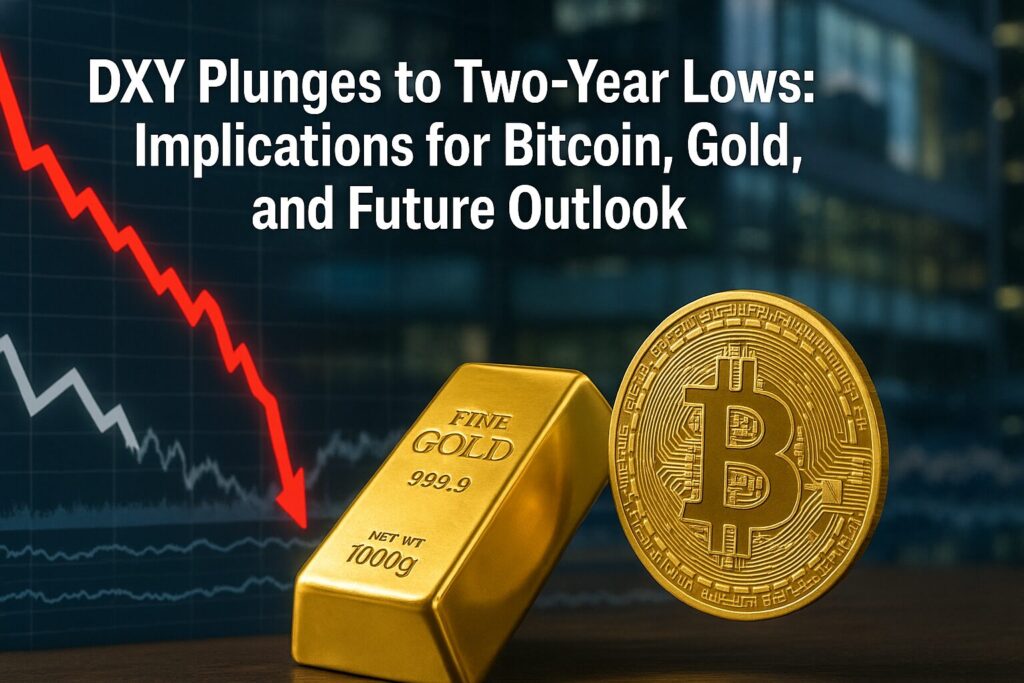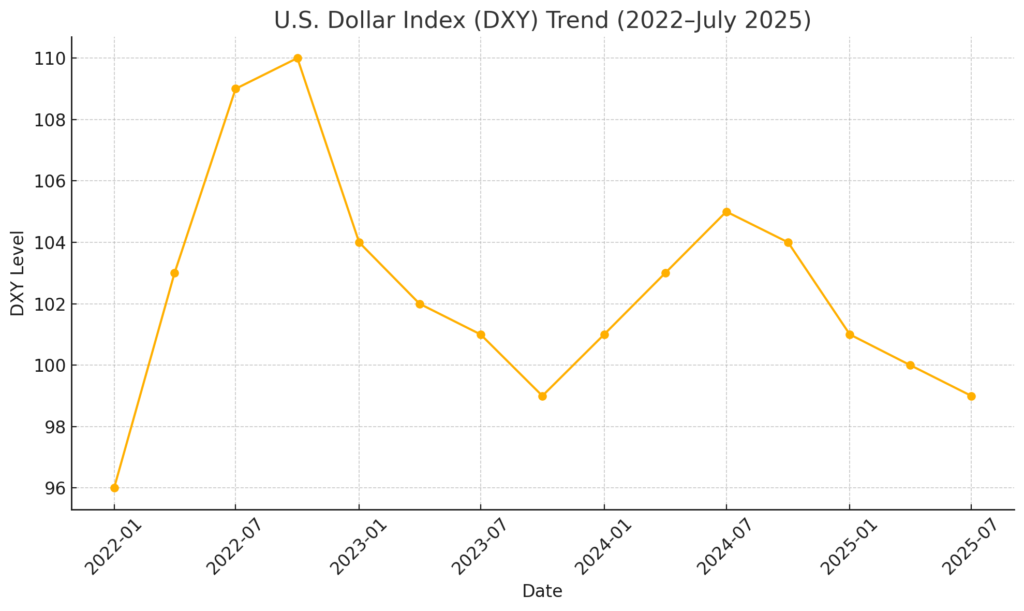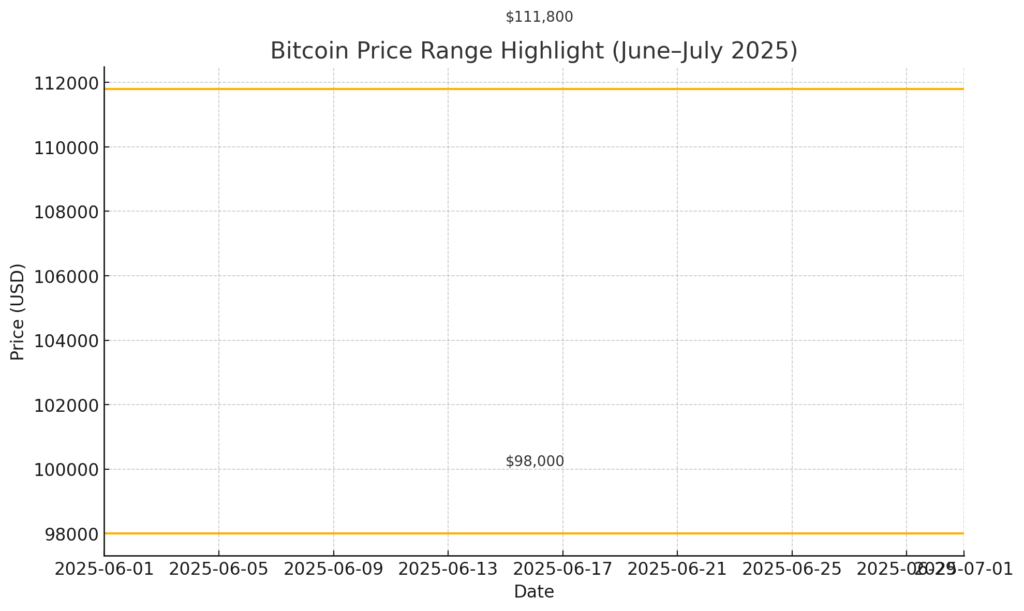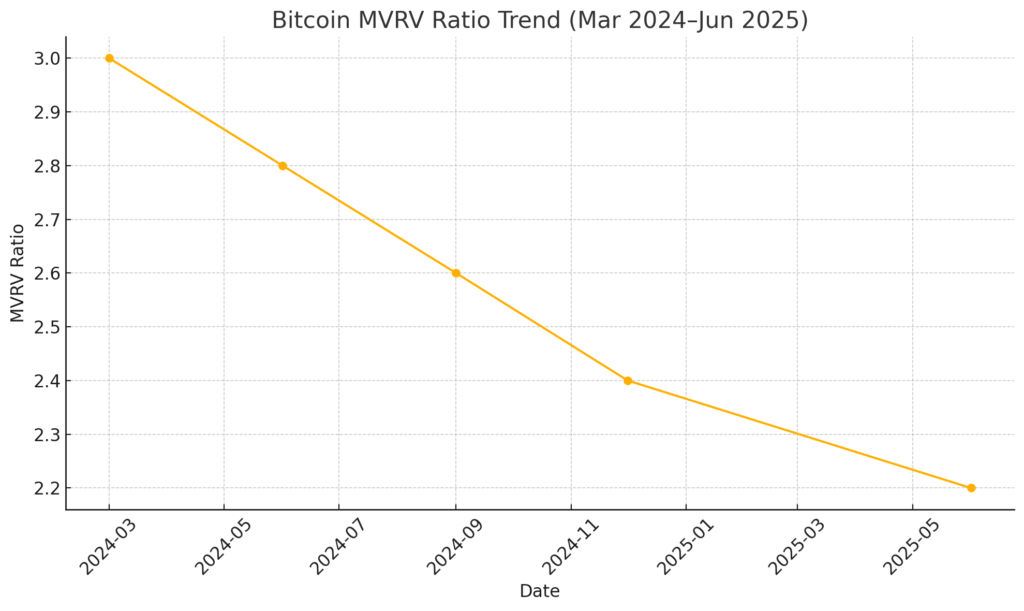
Main Points:
- U.S. Dollar Index (DXY) is at its lowest since 2022, signaling weakened confidence in the dollar.
- S&P 500 and other risk assets are benefiting from a rotation out of the dollar, with the S&P 500 hitting record highs around $6,212.
- Gold has rallied strongly year-to-date but stalled over the past two months despite the U.S. dollar’s weakness.
- Bitcoin remains range-bound between $98,000 and $111,800, failing to break out despite ETF inflows and corporate purchases.
- The positive correlation between Bitcoin and gold persists, with both trading sideways amid macroeconomic shifts.
- Long-term Bitcoin holders’ (LTH) unrealized gains have dipped toward levels last seen in October 2024, with an average MVRV ratio of ~2.2× (220%).
- Historical peaks in LTH unrealized gains (3.0–3.5× in early/late 2024) suggest Bitcoin may need to reach roughly $140,000 to revisit prior cycle highs.
1. DXY at Two-Year Lows and Risk Asset Rotation

Over the past quarter, the U.S. Dollar Index (DXY) has declined steadily, reaching levels not seen since mid-2022. This drop reflects a broader loss of confidence in the dollar amid signs of slowing U.S. economic growth and dovish signals from the Federal Reserve. As the dollar weakens, capital has flowed into riskier assets: the S&P 500 climbed to an all-time high near $6,212, reversing losses from the April 2025 macroeconomic sell-off and highlighting a clear rotation from greenbacks into equities and other risk-on instruments (see chart above).
2. Gold’s Pause Amid Dollar Weakness
Gold rallied strongly in early 2025, buoyed by inflation concerns and safe-haven demand. By mid-June, it had posted year-to-date gains exceeding 10%. However, despite the U.S. dollar’s continued slide, gold prices have traded in a tight range over the last two months, suggesting a consolidation phase. Investors appear cautious, balancing dollar weakness against prospects of Fed rate cuts and moderating inflation.
3. Bitcoin’s Struggle to Break Free

Despite significant inflows into spot Bitcoin ETFs and notable corporate acquisitions, Bitcoin has remained trapped in a roughly 10% trading band between $98,000 and $111,800 (see chart above). Current prices sit about 4% below the latest cycle high, indicating a lack of fresh catalysts to drive a sustained breakout. The enduring range-bound behavior suggests market participants are weighing macro uncertainties against bullish on-chain developments.
4. Positive Correlation Between Bitcoin and Gold
Bitcoin and gold have maintained a strong positive correlation over the past several months. Both assets have been largely range-bound since May 2025, despite the DXY’s downward trajectory. This pattern underscores Bitcoin’s growing role as “digital gold” among investors seeking diversification and protection against fiat currency depreciation.
5. LTH Unrealized Gains and MVRV Ratio Analysis
CryptoQuant analyst Darkfrost highlights that long-term Bitcoin holders’ (LTH) unrealized gains have fallen to levels last observed during the October 2024 market correction. The average MVRV ratio—Market Value to Realized Value—has declined from cycle-peak highs of ~3.0× (March 2024) and ~3.5× (December 2024) down to ~2.2× (June 2025), indicating reduced aggregate profitability among LTH.
- Current Realized Price: $39,000 (average acquisition cost), implying most LTH still hold significant unrealized gains.
- Historical Peaks: MVRV at 3.0× corresponded to Bitcoin prices near $117,000 in March 2024; 3.5× aligned with ~$136,500 in December 2024.
- Breakout Target: To restore LTH unrealized gains to previous highs, Bitcoin would need to surge to approximately $140,000.

(See chart above for MVRV trend visualization.)
6. Recent Market Developments and Outlook
Beyond CryptoQuant’s analysis, other market trends worth noting include:
- ETF Adoption: Adoption of spot Bitcoin ETFs continues to broaden, with new products launching in Asia and Europe, increasing institutional inflows.
- Stablecoin Growth: U.S. regulatory clarity on stablecoins is fostering growth in on-chain payment use cases.
- Macro Risks: Potential Fed rate cuts later in 2025 could reignite risk-on rallies but also inject volatility if growth disappoints.
- On-chain Metrics: Rising wallet balances at exchanges and declining miner sell pressure hint at accumulation phases rather than distribution.
These factors suggest that while Bitcoin and gold trade sideways, underlying demand drivers remain intact.
Conclusion
The U.S. dollar’s slide to its weakest point since 2022 has catalyzed gains in equities, gold, and crypto, yet both gold and Bitcoin have entered consolidation phases. Bitcoin’s range-bound trading and diminishing LTH unrealized gains point to a market awaiting fresh catalysts—whether regulatory developments, macroeconomic shifts, or new institutional entrants. Investors seeking new crypto assets and income sources should monitor ETF flows, on-chain metrics, and macro indicators closely. A breakout above $111,800 and especially a rally toward $140,000 could mark a return to historically profitable territory for long-term holders and signal the next major leg in Bitcoin’s bull cycle.

